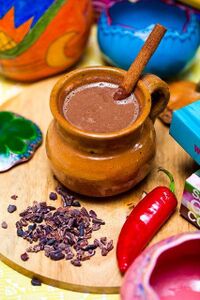Mutulese Chocolate: Difference between revisions
No edit summary |
No edit summary |
||
| Line 5: | Line 5: | ||
Two concepts central to the better Mutuleses chocolates are the {{wp|terroir|Nal}}, which links the style of the chocolate to the locations where the cacao are grown and transformed. The second is the ''Divine Mark'' that certifies the origin and the quality of the chocolate. The rules of the attribution of the Divine Mark closely define which cacao varieties and transformation practices are approved for classification in each of the Mutul's 75 000 exploitations. These rules only cover the production and distribution of liquid chocolate, chocolate tablets and "solid chocolate" do not show the same level of regulation, as they are not considered socially to be as prestigious. | Two concepts central to the better Mutuleses chocolates are the {{wp|terroir|Nal}}, which links the style of the chocolate to the locations where the cacao are grown and transformed. The second is the ''Divine Mark'' that certifies the origin and the quality of the chocolate. The rules of the attribution of the Divine Mark closely define which cacao varieties and transformation practices are approved for classification in each of the Mutul's 75 000 exploitations. These rules only cover the production and distribution of liquid chocolate, chocolate tablets and "solid chocolate" do not show the same level of regulation, as they are not considered socially to be as prestigious. | ||
==History== | |||
===Early days=== | |||
Evidence suggest that the cacao tree was first cultivated by humans for its pods' sweet pulp. Fermented, it was served as an alcoholic beverage in the Mutul since 1400 BCE. The first real evidences of the culture of cacao are from [[Sante Reze]], and date back to more than 5000 years ago. | |||
Depiction of offerings of cacao to the gods or to mortal rulers during the [[Paol'lunyu Dynasty]] show that it was the kakaw drink that was used for exchanges, not yet to cocoa beans themselves. | |||
===Cocoa bean as money=== | |||
==Kakawnal== | ==Kakawnal== | ||
Revision as of 20:32, 9 September 2021
This article is incomplete because it is pending further input from participants, or it is a work-in-progress by one author. Please comment on this article's talk page to share your input, comments and questions. Note: To contribute to this article, you may need to seek help from the author(s) of this page. |

Chocolate, (Mutli: "Kakaw") is produced all throughout the Mutul, in quantities between 9,000 and 20,000 tons of tablets and 9 - 10 millions of bottles per year. The Divine Kingdom is the largest producer of liquid chocolate in the world, and one of the two largest exporters of cacao alongside Sante Reze. Chocolate is almost cosubstantial with the country, as traces of chocolate beverages and vessels associated to its consommation can be found even in the oldest archeological sites. It is supposed that the cultivation of the cacao tree was brought north from the Ucayare forest by nomadic populations of agro-forester. The chocolate produced range from expensive chocolates sold internationally to modest creations usually only seen within the Divine Kingdom.
Two concepts central to the better Mutuleses chocolates are the Nal, which links the style of the chocolate to the locations where the cacao are grown and transformed. The second is the Divine Mark that certifies the origin and the quality of the chocolate. The rules of the attribution of the Divine Mark closely define which cacao varieties and transformation practices are approved for classification in each of the Mutul's 75 000 exploitations. These rules only cover the production and distribution of liquid chocolate, chocolate tablets and "solid chocolate" do not show the same level of regulation, as they are not considered socially to be as prestigious.
History
Early days
Evidence suggest that the cacao tree was first cultivated by humans for its pods' sweet pulp. Fermented, it was served as an alcoholic beverage in the Mutul since 1400 BCE. The first real evidences of the culture of cacao are from Sante Reze, and date back to more than 5000 years ago.
Depiction of offerings of cacao to the gods or to mortal rulers during the Paol'lunyu Dynasty show that it was the kakaw drink that was used for exchanges, not yet to cocoa beans themselves.
Cocoa bean as money
Kakawnal
The Mutul possess many "Kakawnal", agricultural plantations dedicated to the cultivation of the cacao trees (Mutli: Kakaw T'e). Each has soils, practices, and an history characteristic of the parcel. It's on these specificities that the "Nal" is defined.